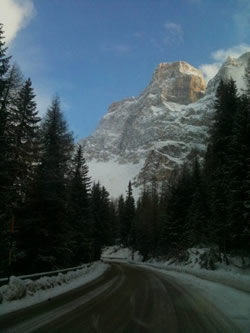- Home » Expat Articles » Driving » How to Drive Like an Italian - after you've passed your Italian Driving Test!
How to Drive Like an Italian - after you've passed your Italian Driving Test!
| Published: | 12 Mar at 11 AM |
Want to get involved?
Become a Featured Expat and take our interview.
Become a Local Expert and contribute articles.
Get in touch today!
Become a Local Expert and contribute articles.
Get in touch today!
Filed: Driving,Italy
Local Expert Series: How to Drive like an Italian by Catherine McNamara
Driving in Italy will sharpen your wits. If you suffer from high blood pressure you should be careful. If you don't, make sure you exercise calming techniques as you hit the road.
In Italy you will see every road rule broken with regularity. Speed limits are disregarded. Young children are beltless in front or rear seats (you may even see a dog in a driver’s lap). Pedestrians risk their lives when on zebra crossings. And your vehicle will most probably be overtaken on a blind curve by a guy on a mobile phone driving an Audi.
Beware! It's not advisable to respond with reciprocal road rage as you may be followed and sworn at. But do triple check in your rear view mirror when at a crossing as you may be hit from behind. Italians also have a deathly penchant for walking along the roadside in the same sense as the traffic, rather than facing oncoming cars. So, in the dead of night, you might see someone walking between villages dressed in dark clothing! Be careful!
On the official side things are also tricky. Rather than punish speeding, driving while telephoning or reckless driving, you are more likely to receive a fine for parking. The point system was only introduced within the last ten years in Italy, and some drivers are still outraged (20 points for a Patente B i.e. car license). You may be stopped by either traffic police or more menacing carabinieri and asked for your documents. Breath-testing is becoming more widespread and Italians, who drink wine with meals and enjoy their bar-hopping as much as anyone, haven't cottoned on to the concept of a non-drinking party member to safely take revellers home. Fines are steep and in serious cases your car may be confiscated.
If you are a legal resident in Italy you may drive with an international driver's license for one year, after which time you must sit for your Italian license. E.U. license holders are lucky enough to be able to convert theirs to an Italian one, as will nationals from the list posted on the Ministry of Transport's site, however nationals from Canada, the USA, Australia, NZ, most African and Asian countries will have to sit the test. If your Italian is awful it may be best to take some grammar lessons: it is no longer possible to sit for the test in English as it was in the past. The theory exam is only in Italian (except in Valle d'Aosta where you may also sit for it in French, and Sud Tirol where you may choose German) and is held at your local Motorizzazione Civile. You must answer ten very trickily worded questions and only four errors are allowed.
The easiest way to prepare your test even if - as I had - you have been driving for decades , is to enrol yourself in a local driving school. The driving school scenario can be like a scene from the old British sitcom 'Mind Your Language'. Imagine this: a roomful of local eighteen-year-olds and a selection of Senegalese and Chinese factory workers studying road rules in Italian. It can be a lot of fun. To enrol in a driving school you will have to show your residence documents and carte d’identità, and do an eye test and provide a medical certificate (many schools will arrange this). Then you can attend classes for as long as it takes you to absorb the Italian Codice della Strada. (If you are smart you may also apply directly to your local Motorizzazione Civile and study as a 'privatista'.)
Instructors will give you tips and get you through the road rules faster. (Tip: the practical test may be slightly easier in a country area where there is less turbulent traffic!) Expect to pay at least 500euro for the whole process - this includes paperwork to apply for your driving exam, medical check, enrolment at a driving school for theory lessons and material, practical lessons, arranging of exams and the exams themselves. Should you apply as an independent, costs will be lower but the paperwork and running around factor will increase.
As of January 19th 2013 you must pass your theory exam before you can apply for your learner's permit, your foglio rosa (pink sheet). If you are a young teen, you may apply for this on the day after you turn eighteen. The foglio rosa allows you five months to practice driving on the roads - with an instructor, or a driver who has had an Italian license for 10 years. You have two chances to attempt your practical exam before your permit expires. When driving with your learner's permit a 'P' must be displayed to indicate the driver is a principiante, and you may not drive on the autostrada or in busy areas of town or you risk a fine!
If you pass - congratulazioni! - your new Italian license is valid for ten years and allows you to drive all over Europe. Now you can drive as madly as everyone else!
Comments » There are 3 comments

Alba Brunetti wrote 12
years ago:
Wait, there are road rules? Next you'll be telling me there are traffic lights and stop signs.

Margaret wrote 12
years ago:
After being here 11 years..I have also found that in Italy..stop signs, crosswalks, speed limits, road rules in general, are merely suggestions! And remember that the flashing of lights is not a courtesy to let you pull out..it is a "don't you dare pull out in front on me"...Every point you made was well said and so true!

Nina Hansen Machotka wrote 12
years ago:
Well done, Catherine! I've been wanting to write up my experience through all of this but haven't gotten to it. I was giggling throughout, remembering all that I went through. Just one little thing at the end (unless the law has changed?). That is, once you get your license, you're on "probation" for 3 years. It's kind of an baby license and has rules that go along with it--no more than 90 km/hr on highways, no more than 110 km/hour on autostradas (ridiculous as you'll cause an accident this way), and absolutely NO alcohol. After 3 years, you renew and then you're a real adult driver. Geesh...I've been driving for 40 years in the U.S. and Europe, and I've been a baby driver in Italy for 2 1/2 years...come November I get to grow up :-).


 Catherine McNamara studied graphic design and modern African history before running off to Paris to become a writer. She worked in an embassy in Mogadishu before the war, has translated welding manuals and modelled shoes, and co-ran a bar and gallery in Accra, Ghana. She now lives in northern Italy where she is restless but staying put. She is the author of the erotic comedy ‘The Divorced Lady’s Companion to Living in Italy’ (Indigo Dreams Publishing UK), the collection of mostly Africa-based stories ‘Pelt and Other Stories’(coming out in April 2013, Indigo Dreams Publishing UK) and her blog.
Catherine McNamara studied graphic design and modern African history before running off to Paris to become a writer. She worked in an embassy in Mogadishu before the war, has translated welding manuals and modelled shoes, and co-ran a bar and gallery in Accra, Ghana. She now lives in northern Italy where she is restless but staying put. She is the author of the erotic comedy ‘The Divorced Lady’s Companion to Living in Italy’ (Indigo Dreams Publishing UK), the collection of mostly Africa-based stories ‘Pelt and Other Stories’(coming out in April 2013, Indigo Dreams Publishing UK) and her blog.




